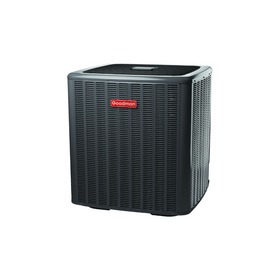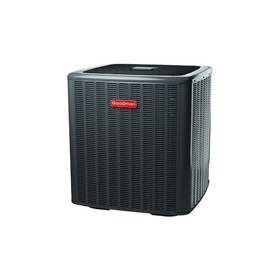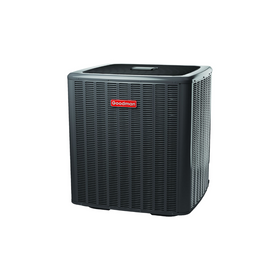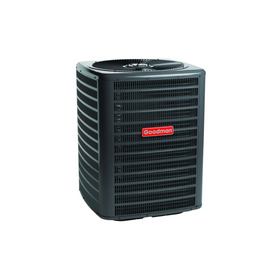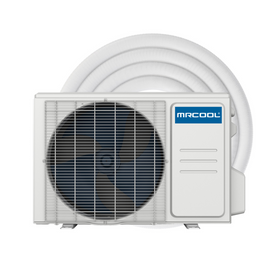
Heat Pumps: The Ultimate Guide
Last Updated: Feb 11, 2025While most heating and cooling methods still release greenhouse gases, electric heat pumps can be a great way to reduce our reliance on fossil fuels. An EIA survey found that over 12 million households in the United States use heat pumps. In 2019, 3.11 million air-source heat pumps were shipped in the United States, up from 2.27 million in 2015. The increase in electric heat pump adoption is expected to continue as electric heat pumps' efficiency increases.
Is the switch to an electric heat pump always going to be the most environmentally friendly decision? Not necessarily. Switching in States that rely heavily on fossil fuels such as coal, natural gas, and petroleum for electricity generation may have a minimal net impact. However, states like California, Vermont, Washington, Maine, and Oregon have tabled action plans to provide a clean and renewable energy mix less reliant on fossil fuels. For example, approximately 25% of California's greenhouse gas emissions come from buildings that burn gas or propane in furnaces and water heaters. A 2018 report prepared for the NRDC concluded that emissions would fall by 7 million metric tons annually if one-third of California buildings switched to clean electric heat. That's the equivalent of having 1.5 million cars off the road every year!
Electric heat pumps can be a great way to reduce our reliance on fossil fuel sources for heating. In this guide, we offer a complete introduction to heat pumps. We'll explain what they are and how they function before explaining the difference between the three most common types of heat pumps on the market today. We'll turn our attention to the efficiency ratings associated with heat pumps, focusing on SEER ratings. We'll also look at a few considerations that should help you decide which heat pump is the best for your home. Finally, we look at the potential savings made by switching to a heat pump for your household heating and cooling needs.
Table of Contents
- What is a Heat Pump?
- How Do I Know If I Have a Heat Pump?
- How Long Should a Heat Pump Run?
- How Much Do Heat Pumps Cost?
- How Much Can a Heat Pump Save You?
- What Temperature Is a Heat Pump Not Effective?
- Heat Pump Types
- What Is a Ducted Air Source Heat Pump?
- What Is a Ductless Air Source Mini-split Heat Pump?
- What Is a Geothermal (Ground Source) Heat Pump?
- What Is a Good Efficiency Rating for a Heat Pump?
- What Size Heat Pump Do I Need?
- How to Defrost a Heat Pump
- Why Won't My Heat Pump Go Into Defrost Mode?
- What Do You Do When Your Heat Pump Freezes in the Winter?
- How Long Does a Heat Pump Last?
- How Do You Reset Your Heat Pump?
- What to Know Before Purchasing a Heat Pump for Your Home
What is a Heat Pump?
A heat pump is a device that moves heat from the outdoors to the indoors, or vice versa, depending on your needs. Like a refrigerator, the heat pump evaporates refrigerant at low pressure to absorb heat from its surroundings and then condenses the refrigerant at high pressure on the other coil to release the heat absorbed earlier. This process can either warm or cool your home. The energy savings are fantastic over electric baseboard heaters, especially in North American climates with high weather variance.

Heat Pumps can supply warm air to your home on cold days. Even when temperatures go down to -18°C (0°F), heat pumps can still retain 85% of the warmth they had at 21°C (70°F). The key to this heating ability is the specialized refrigerant that maximizes heat transferability. The first generation of heat pumps relied on Freon-type refrigerants known as R-22 refrigerants (HCFC-22). These refrigerants pose a significant health risk to people who have a history of heart problems due to concerns of Freon exposure leading to cardiac arrhythmia (irregular heartbeat). As a hydrochlorofluorocarbon, Freon also led to the depletion of the ozone layer. As of January 1st, 2020, R-22 is being phased out in the US and Canada. Also, there is a ban on the production and import of HCFC-22.
Today, most heat pump manufacturers rely on more eco-friendly refrigerant options. However, heat pumps initially designed for R-22 (Freon) refrigerants cannot be adapted for other types of refrigerants. It is essential to ensure that the heat pump you choose has been designed for more sustainable refrigerant options.
Besides the differences in the type of refrigerant used, there are other vital variances between different heat pumps. Whether you enjoy saving on your heating bill or having an efficient air conditioning unit, there are a few things we recommend before buying a new unit.
How Do I Know If I Have a Heat Pump?
Every heating and cooling unit should have an efficiency label. This label will state if you have an air conditioning unit or a heat pump. If you cannot determine if you have a heat pump, your unit may have an EnergyGuide label (or EnerGuide in Canada). EnergyGuide labels typically have two numbers present; Seasonal Energy Efficiency Ratio (SEER) and Heating Seasonal Performance Factor (HSPF). A SEER rating indicates how efficiently a heat pump cools a space, and HSPF represents how efficiently they heat an area (HSPF). If these numbers are present, then you have a heat pump.
If you cannot conclude via the label, the following quickest way to determine if you have a heat pump is to find the manufacturer name and model number. Using a search engine, search the manufacturer name and model number to learn more about the product's features.
If the label and model number do not provide enough information, you can turn the heat on your thermostat. If hot air starts coming from your vents, head outside to confirm that your unit is running. If so, you have a heat pump.
Heat pump condensers have a reversing valve. This part is responsible for reversing the refrigerant flow, enabling a heat pump to heat or cool your home. If you look directly down through the grates of the condenser, you should see a brass-colored device with three fittings on the same side. If there is a reversing valve, then you have a heat pump. It may not always be easy to locate the reversing valve, so this method is a last resort.
How Long Should a Heat Pump Run?
Heat pumps are very efficient at heating your home and are designed to run 24/7 during cold weather. If your heat pump continuously runs in cooling mode during warm summer weather, there could be a problem, and your heat pump may require service. If this is the case, the most common issues are dirty air filters that need cleaning, your thermostat has not been correctly set up, or an issue with the condensate pump. If you've checked these common occurrences and the problem persists, schedule a service call with a local heating and cooling expert.

How Much Do Heat Pumps Cost?
You can expect to pay $2,000 for smaller and less efficient heat pump models and up to $7,500 for the best and most efficient larger heat pumps on the market. Homes with a sturdy building envelope, energy-efficient windows, and high-performance insulation will be able to get by with smaller (and less expensive) heat pumps.
How Much Can a Heat Pump Save You?
Heat pumps can save around 40 percent on your annual heating and cooling bills. More energy-efficient households and homes located in warmer climates can expect to save even more. According to the US Department of Energy, the average household expense for utility bills is around $2,200. An average of 40 percent savings amounts to $880 per year with a payback period of 2.5 years for smaller units priced at $2,000 and 8.5 years for more expensive units that cost up to $7,500.
What Temperature Is a Heat Pump Not Effective?
It depends on what heat pump you buy! Heat pump units are becoming increasingly efficient and effective. It is a good idea to have a secondary source of heat in your home in colder climates. Heating experts recommend a secondary heat source if temperatures go below 30°F, but some units are now effective down to -25°C (-13°F).
For areas with mild winters where temperatures temporarily go below freezing, a wood stove or fireplace might be all that is needed. If you need supplemental heat for cold winters, electric baseboard heaters for zone heating can be an efficient heating option over central heating furnaces. They can even be able to be powered with a rooftop PV system. For cold climates, look for heat pumps with higher HSPF ratings, and for warm temperatures, look for higher SEER ratings.
External Factors
- Installing proper insulation for your home is the single most significant contributor to your heat pump's success. Your basement, attic, and walls need adequate insulation to keep the warm air during colder months and cool air during warmer months.
- Reduce air leaks by properly sealing your home. You can find the best ways to do this with this handy guide.
- Sealing and insulating ductwork, especially in basements and attic spaces, will drastically increase your home's energy efficiency.
- Get a smart thermostat, or at minimum, a programmable thermostat. Central heating and cooling units work best when they're optimized to operate at appropriate times, and the proper control units can save you as much as an additional $70 to $90 per year.

Heat Pump Types
There are three types of heat pumps used for household heating and cooling. While there are other options, the typical mainstream models typically fall within these three categories.
What Is a Ducted Air Source Heat Pump?
A ducted air-source heat pump can provide efficient heating and cooling for your home. When properly installed, an air source heat pump can deliver one-and-a-half to three times more heat energy to a home than the electrical energy it consumes. This is possible because a heat pump moves heat rather than converting it from fuel as combustion heating systems do. Air-source heat pumps are an energy-efficient alternative to furnaces and air conditioners. They are also the most common type of heat pump used in homes. When appropriately installed, heat pumps can also supply the house with a steady hot water supply. This reduces the need for a separate hot water heater, another energy-intensive aspect of traditional houses.
What Is a Ductless Air Source Mini-split Heat Pump?
Ductless mini-split-system heat pumps are excellent retrofit add-ons for houses without ducted heating systems, such as hot water heat, radiant panels, and space heaters such as wood, kerosene, or propane. They are an excellent choice for room additions where extending or installing ductwork is not feasible or new homes requiring only a small space conditioning system. A ductless mini-split heat pump might be the best transition away from your old natural gas furnace and central air conditioning unit for households looking to do a passive house retrofit.
What Is a Geothermal (Ground Source) Heat Pump?
As with any heat pump, geothermal and water source heat pumps can heat, cool, and, if so equipped, supply the house with hot water. Some models of geothermal systems are available with two-speed compressors and variable fans for more comfort and energy savings. Relative to air-source heat pumps, they are quieter, last longer, need little maintenance, and do not depend on the outside air temperature. A complete geothermal heating system is a significant financial investment for any home. Still, it can provide your home with all its heating and cooling needs in a renewable and sustainable manner.
What Is a Good Efficiency Rating for a Heat Pump?
Heat pumps, like all appliances, must contain a federal "EnergyGuide" label that determines the unit's energy efficiency for both heating and cooling a home. While heat pumps can reduce the energy and fossil fuels needed to heat and cool your home, there are significant differences in energy efficiency ratings.
The two most widely used efficiency rating standards for heat pumps are SEER and HSPF. Both of these measurements are determined by observing and evaluating the performance of a heat pump over a year.
SEER is an evaluation of the efficiency of a specific heat pump model when it is used for cooling or air conditioning. Remember, heat pumps (despite their name) are used to heat and cool a home. The SEER rating is calculated by dividing the amount of cooling required of a home in BTUs by the total electricity used. The higher the SEER rating, the more energy-efficient the heat pump will be for cooling your home during the summer. All heat pumps in the US have a minimum efficiency requirement of 13 as mandated by the Department of Energy.
The Heating Seasonal Performance Factor (HSPF) is similar to SEER in that it determines the amount of heating in BTUs divided by the total amount of electricity used. However, it also includes calculations for energy needed to defrost the pump during cold spells and any backup heating requirements required to keep the home at a comfortable temperature.
Energy Star heat pumps will generally have a SEER rating anywhere between 18 and 27.5 and an HSPF rating between 8.5 and 12.5.
For geothermal heat pumps, the Energy Efficiency Ratio (EER) and COP (Coefficient of Performance) are the energy-efficient indicators you should look for. The EER minimums are 17.1 to 21.1, and the COP minimums are 3.1 to 4.1. Typically, the higher the efficiency, the higher the unit's price.
In general, a heat pump system will need about 1 ton for every 400 square feet of your home. A 2,000 square foot home, then, would require a 5-ton heat pump, though a passive house with high-performance insulation might be able to source a smaller-sized pump.
Undersized heat pump units will work too hard, while oversized units will work too infrequently. Both scenarios work against you in helping to save money. Hiring a professional installer will help you determine the best-sized heat pump for your home.
Why Won't My Heat Pump Go Into Defrost Mode?
The most common reasons a heat pump won't go into defrost mode are a lack of drainage, the absence of coolant flow inside the heat pump, or a shortage of airflow. The heat pump may be positioned too low in the ground in remote cases. Look for apparent issues needing adjustment and call a heating and cooling expert if the problem persists.
What Do You Do When Your Heat Pump Freezes in the Winter?
If ice builds up and prevents your heat pump from operating correctly, it signals a problem with its defrosting capability. A heat pump ice buildup can be caused by low refrigerant levels, dirty air filters, blower motor coil, or fan blade blockage. It's also possible that your heat pump could have a malfunctioning blower motor, thermostat, or temperature sensor. Schedule a service call with a heating and cooling expert as soon as possible to reduce any long-term damage that could occur.
How Long Does a Heat Pump Last?
A well-maintained heat pump can last 15-20 years, if not more. Climate and other operating factors also impact a heat pump lifespan. Most heat pump manufacturers offer warranty programs protecting your unit for ten years. Warranties are a critical component to consider when buying a heat pump. Not all warranties are created equal. It's essential to understand what is and isn't covered under warranty.
How Do You Reset Your Heat Pump?
Most heat pumps can be reset via the remote, turning the system off with the thermostat or turning the breaker off and then back on. If you reset the breaker, wait 60 seconds before turning it back on. It could take between 5 to 10 minutes for the outdoor unit to start. Consult your heat pump user manual for reset instructions and troubleshooting.

What to Know Before Purchasing a Heat Pump for Your Home
Several factors should be considered when looking for the best heat pump for your needs.
Have a Professional Install Your Heat Pump
You should have a professional install the heat pump that you eventually settle on. We can't overemphasize enough that installing a heat pump should be left to HVAC specialists. A heat pump is a significant investment, so make it worth your while and get a pro to install it for you. This will ensure that your home receives all the heating and cooling benefits that come with a heat pump.
Heat Pump Incentives and Rebates
Energy utility companies and local and state governments promote heat pumps because they promise energy savings. Heat pumps reduce reliance on fossil fuels and help cities and towns reach some of their sustainability and greenhouse gas reduction targets. Therefore, several incentives and rebate programs are catered to these products.
On a national level, air-source heat pumps that are Energy Star certified automatically qualify for a $300 tax credit. On a local level, you might be able to receive further discounts, rebates, or incentives with programs through your local utility company. If you connect a heat pump to an existing geothermal system, other rebates are most likely available to you. Check out our rebate finder for more info on incentives in your area.
Tobias Roberts
Tobias runs an agroecology farm and a natural building collective in the mountains of El Salvador. He specializes in earthen construction methods and uses permaculture design methods to integrate structures into the sustainability of the landscape.




